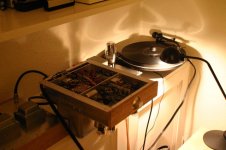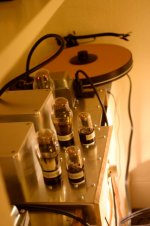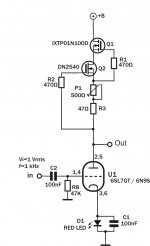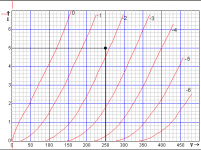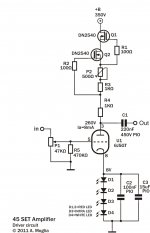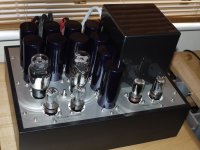I ended up with three chassis as I ran out of space on the HT chassis
HT chassis has also the bias supply and 8 core cable to the main chassis.
LT supply chassis is housing two e-core trannies for the 45s and one toroidal trannie I had at hand for the driver filament supply. On this chassis I have three raw supply boards and another multipole connector with 4 core cable from this chassis to the main one.
Cheers,
Ale
Do you run a separate ground for each channel back to the HT chassis ? If you have the time I'd be interested in your grounding scheme, I'm having issues with just a separate HV transformer/HVSS for each channel being in different chassis's.
Hi!
Seems you have a ground loop. Care needs to be taken with grounds when you have a separate PSU. All grounds (if you have separate transformers) should come together at a single point, preferably in the amp chassis.
Thomas
I'm having issues with just a separate HV transformer/HVSS for each channel being in different chassis's.
Seems you have a ground loop. Care needs to be taken with grounds when you have a separate PSU. All grounds (if you have separate transformers) should come together at a single point, preferably in the amp chassis.
Thomas
Hi!
Seems you have a ground loop. Care needs to be taken with grounds when you have a separate PSU. All grounds (if you have separate transformers) should come together at a single point, preferably in the amp chassis.
Thomas
Indeed. I have one single point in the main chassis where all grounds are connected. This point is the only contact with the chassis to avoid ground loops. Also is the input of the driver input potentiometer. The line input signal is wired from the back connectors with shielded cable to this point as well.
BTW: I tested the amplifier last night with the fostex speakers. Very surprised and pleased with the sound, fantastic bass response which evidently my EL34 PP was lacking off. Tone is clear and rounded. For my current setup the nearly 2W this amplifier can deliver is more than enough! I was worried about the power required, but this really proves that 2W can be quite a lot!
Well, this glory moment had to end with a bit of smoke! The darned multipole connector is making false contact - I knew this, but I still went ahead with the test despite the warning and risk. Obviously the bias supply connection failed and the poor 45s were at the mercy of full current. Luckily my RC filter (1k2 + 47uF) to drop HT voltage from 350V to 300V felt the pain first. The resistors burnt and I managed to switch off the amplifier....
Lesson learnt: will add a fuse to the cathode return for the 45s and also will change these multipole connectors!
Cheers,
Ale
Attachments
Hi Ale,
first congrats for the amp! Glad that you like the sound! many people are surprised how far 2W can go when they hear it the first time!
Sorry about the incident with the bias failure. If you add a fuse to the cathode circuit, it is a good idea to put a resistor in parallel, say a few kOhms. This way the current will not be totally interrupted when the fuse blows which can cause a nasty voltage spike in the output transformer, when the inductance tries to discharge. With the resistor the tube will go in kind of a cathode bias mode. 4,7k would be ok.
It is worth trying cathode bias, with the ultrapath scheme I prefer that to fixed bias. Makes the amp simpler, avoids such problems and sounds just as good IMHO
Best regards
Thomas
first congrats for the amp! Glad that you like the sound! many people are surprised how far 2W can go when they hear it the first time!
Sorry about the incident with the bias failure. If you add a fuse to the cathode circuit, it is a good idea to put a resistor in parallel, say a few kOhms. This way the current will not be totally interrupted when the fuse blows which can cause a nasty voltage spike in the output transformer, when the inductance tries to discharge. With the resistor the tube will go in kind of a cathode bias mode. 4,7k would be ok.
It is worth trying cathode bias, with the ultrapath scheme I prefer that to fixed bias. Makes the amp simpler, avoids such problems and sounds just as good IMHO
Best regards
Thomas
Hi Thomas,
Many thanks to you, as you helped me quite a lot along the way. I'm absolutely surprised with the sound and happy to see that 2W is more than enough for me!
I will do as you said. I still need to finish the bottom part of the chassis and feet.
I may try cathode bias. What is the ultrapath scheme?
I also will try the 6N7 driver once I build my 26 pre-amp which is my next project!
Thanks again,
Ale
Many thanks to you, as you helped me quite a lot along the way. I'm absolutely surprised with the sound and happy to see that 2W is more than enough for me!
I will do as you said. I still need to finish the bottom part of the chassis and feet.
I may try cathode bias. What is the ultrapath scheme?
I also will try the 6N7 driver once I build my 26 pre-amp which is my next project!
Thanks again,
Ale
Hi!
That is a capacitor from B+ side of the transformer to cathode, this effectively bypasses the cathoderesistor and it's bypass cap. In many cases the bypass cap can be left out with ultrpath.
Check the single ended amplifier concept series of posts on my blog for schematics, for example this one:
VinylSavor: Single Ended Amplifier Concept, Part 7
Best regards
Thomas
I may try cathode bias. What is the ultrapath scheme?
That is a capacitor from B+ side of the transformer to cathode, this effectively bypasses the cathoderesistor and it's bypass cap. In many cases the bypass cap can be left out with ultrpath.
Check the single ended amplifier concept series of posts on my blog for schematics, for example this one:
VinylSavor: Single Ended Amplifier Concept, Part 7
Best regards
Thomas
Moglia, if you put the star ground in the amp chassis, does this mean the B+ prefiler grounds are wired up to the amp chassis and not connected to their chassis?
Hi,
Yes. There's is no -B connection to chassis on the HT chassis, this is wired to the main chassis star connection. Filaments are floating and only the 45 heater + is grounded in my case as I have fixed bias. see Rod Coleman's instructions for more details on this.
Cheers,
Ale
At last, it's alive!
Hi everyone,
Finally and after a long 9 month period of weekend work, my 45 SET amplifier has been completed. It sounds brilliant, albeit it has a bit of too much gain when I use my turntable with a preamp.
Thanks everyone who helped me on this journey (Kevin Maier, Thomas, Rod Coleman, Andy Evans amongst others). I managed to learn a lot and still have much more to learn and experience.
This is just fascinating, what else can I say....nothing better than turning on the amplifier and playing one of your favourite LPs. (I did play five years from David Bowie).
A special thank will go to my dad who inspired me all the way and helped me with some building tips and coincidentally yesterday was exactly 3 months since he passed away. I know that he was enjoying this moment with me yesterday when I put the record on and pour a proper glass of single malt to celebrate....
Here are some additional pictures:
Hi-Fi photos
I will probably change the driver stage to lower the gain with a CCS loaded 6N7, 6J5 or paralleled 6SN7GT. I will do some distortion measures first at full drive voltage.
Cheers,
Ale
Hi everyone,
Finally and after a long 9 month period of weekend work, my 45 SET amplifier has been completed. It sounds brilliant, albeit it has a bit of too much gain when I use my turntable with a preamp.
Thanks everyone who helped me on this journey (Kevin Maier, Thomas, Rod Coleman, Andy Evans amongst others). I managed to learn a lot and still have much more to learn and experience.
This is just fascinating, what else can I say....nothing better than turning on the amplifier and playing one of your favourite LPs. (I did play five years from David Bowie).
A special thank will go to my dad who inspired me all the way and helped me with some building tips and coincidentally yesterday was exactly 3 months since he passed away. I know that he was enjoying this moment with me yesterday when I put the record on and pour a proper glass of single malt to celebrate....
Here are some additional pictures:
Hi-Fi photos
I will probably change the driver stage to lower the gain with a CCS loaded 6N7, 6J5 or paralleled 6SN7GT. I will do some distortion measures first at full drive voltage.
Cheers,
Ale
Attachments
Well, still trying to get the best out of the current driver with the paralleled 6SL7 triodes and CCS load. Today I tried the following configurations in order to minimise the stage distortion at maximum drive voltage i.e. 100Vpp. I restricted my test to triodes I had at hand, octal base and 6.3V heaters as I'm not willing to start changing my amp too much. These were the best results so far:
VALVE
6J5GT Brimar @ Ia=15mA/Vg=-3.8V THD=0.46%
6SN7GT Brimar blackened @ Ia=20.5mA/Vg=-7.6V THD=0.32%
Then I tested 16 valves 6SL7/6N9S and achieved the lowest distortion at the following operating point:
Ia=4.5-5mA / Vg=-1.8V, Va=251V
6SL7GT/VT-229 Sylvania THD=0.37%
6SL7GT Brimar (black base) THD=0.42%
6N9S Russian THD=0.43%
The above distortion level of around 0.40% is at full drive of the 6SL7 to achieve the voltage swing I need on my 45 output stage. Distortion is significantly lower at lower signal levels of course. However, in order to optimise the stage, I measured all at the same output level so had to adjust input signal as valves had different mu.
Clearly going for a pair of blackened 6SN7GT will be the best option, but my current CCS board doesn't allow me to include a heatsink for the top mosfet. May need to change the board. But, for a minimum difference I will select a nice pair of 6SL7/6N9S and bias them at 251V anode voltage and Vg=-1.8V using the RED LED bypassed with a russian 100nF PIO capacitor that I have at hand...
Learnt the lesson, if I compare these results with the distortion figures of the CCS loaded 4P1L, CX112, 30 and specially 26 valves that I did earlier, next time I may go for two stages of DHT driver (or one being the preamp) instead of the current setup....
Cheers,
Ale
VALVE
6J5GT Brimar @ Ia=15mA/Vg=-3.8V THD=0.46%
6SN7GT Brimar blackened @ Ia=20.5mA/Vg=-7.6V THD=0.32%
Then I tested 16 valves 6SL7/6N9S and achieved the lowest distortion at the following operating point:
Ia=4.5-5mA / Vg=-1.8V, Va=251V
6SL7GT/VT-229 Sylvania THD=0.37%
6SL7GT Brimar (black base) THD=0.42%
6N9S Russian THD=0.43%
The above distortion level of around 0.40% is at full drive of the 6SL7 to achieve the voltage swing I need on my 45 output stage. Distortion is significantly lower at lower signal levels of course. However, in order to optimise the stage, I measured all at the same output level so had to adjust input signal as valves had different mu.
Clearly going for a pair of blackened 6SN7GT will be the best option, but my current CCS board doesn't allow me to include a heatsink for the top mosfet. May need to change the board. But, for a minimum difference I will select a nice pair of 6SL7/6N9S and bias them at 251V anode voltage and Vg=-1.8V using the RED LED bypassed with a russian 100nF PIO capacitor that I have at hand...
Learnt the lesson, if I compare these results with the distortion figures of the CCS loaded 4P1L, CX112, 30 and specially 26 valves that I did earlier, next time I may go for two stages of DHT driver (or one being the preamp) instead of the current setup....
Cheers,
Ale
Attachments
Hi!
I posted an article about the 45 on my blog within my 'Tube of the Month' series. There are also pics of a recently finished 45 amp:
VinylSavor: Tube of the Month: The 45
Best regards
Thomas
I posted an article about the 45 on my blog within my 'Tube of the Month' series. There are also pics of a recently finished 45 amp:
VinylSavor: Tube of the Month: The 45
Best regards
Thomas
Hi!
I posted an article about the 45 on my blog within my 'Tube of the Month' series. There are also pics of a recently finished 45 amp:
VinylSavor: Tube of the Month: The 45
Best regards
Thomas
Excellent post Thomas, very informative and interesting.
Simple question, I'm looking to change driver, but with space and heater limitation so two options on the table given the existing constrains are 6J5 or 6N7 with CCS load.
What would you recommend between the two?
Have done some successful tests on the 6j5 at 9mA and -8V achieving less than 0.35% THD at 100Vpp. Need to try 6N7 now, any recommendation on the best operating point for this tube to achieve full output drive? BTW: HT supply is restricted to 350-370V
Thanks
Ale
Hi Ale,
the choice depends on your gain requirements. I always go for just as much gain as necessary. So if the 6J5's gain is enough, I would use that.
What would be really interesting to compare is a different driver topology. Like choke loaded or transformer coupled. For those you would need to reduce the B+ for the driver stage to 300V.
I personally prefer the transformer coupling since it offers the possibility to use the ultrapath connection (cap from B+ to cathode).
Best regards
Thomas
the choice depends on your gain requirements. I always go for just as much gain as necessary. So if the 6J5's gain is enough, I would use that.
What would be really interesting to compare is a different driver topology. Like choke loaded or transformer coupled. For those you would need to reduce the B+ for the driver stage to 300V.
I personally prefer the transformer coupling since it offers the possibility to use the ultrapath connection (cap from B+ to cathode).
Best regards
Thomas
Hi Thomas,
With the current 6SL7 driver I have sufficient gain when using CD input, however, when I use my turntable gain is too much as you can notice some clipping on transients when playing at high volume - this is due to the turntable RIAA preamplifier I have which I don't know the gain it has. Evidently the 58-60 gain this stage has is too much when playing vinyl.
I'm planning to build a DHT preamplifier on a separate enclosure using probably a 26, 30 or CX112 or 01a, so this stage will provide some gain around 7-10.
My question was more focused on the linearity of the 6SJ5 compared to the 6N7 as one has a mu of around 20 and the other one around 30 if my memory is correct - sorry I'm not using my home pc at the moment so can't check this.
If I need to drive the 45 at 100vpp to get max output, I was looking to find the optimal bias point to achieve max swing with minimum distortion.
I think as per my previous point I found it for the 6j5, but not for the 6n7 as I don't have a good datasheet showing the transfer curves of 6n7 for anode voltages over 250v
Will have to do some test
Thanks
Ale
With the current 6SL7 driver I have sufficient gain when using CD input, however, when I use my turntable gain is too much as you can notice some clipping on transients when playing at high volume - this is due to the turntable RIAA preamplifier I have which I don't know the gain it has. Evidently the 58-60 gain this stage has is too much when playing vinyl.
I'm planning to build a DHT preamplifier on a separate enclosure using probably a 26, 30 or CX112 or 01a, so this stage will provide some gain around 7-10.
My question was more focused on the linearity of the 6SJ5 compared to the 6N7 as one has a mu of around 20 and the other one around 30 if my memory is correct - sorry I'm not using my home pc at the moment so can't check this.
If I need to drive the 45 at 100vpp to get max output, I was looking to find the optimal bias point to achieve max swing with minimum distortion.
I think as per my previous point I found it for the 6j5, but not for the 6n7 as I don't have a good datasheet showing the transfer curves of 6n7 for anode voltages over 250v
Will have to do some test
Thanks
Ale
Here is a summary of my latest tests of various driver stages to achieve 100Vpp.
All are CCS loaded and LED biased with a 15uF PIO bypass capacitor. LED array varies depending on the bias voltage:
6J5: Tested 8 tubes
Vg=-8.2V, Ia=7.1mA and Va=253-260V
Tube THD
6C2C 0.44% (best)
6J5GT Brimar 0.65% (worst)
6N7: Tested 8 tubes
Vg=-4.7V, Ia=6.5mA and Va=260V
Tube THD
6H7C XI-68 Foton 0.34% (best)
6H7C XI-68 Foton 0.46% (worst)
JAN-CRC-6N7GT RCA 0.60% (best)
So final verdict goes for the 6H7C (Foton -Tashkent, Uzbekistan) with a good 0.34% THD figure. Will be no issue to modify my 6SL7 driver stage to fit the 6H7C. Stage gain will now be around 30, which is more reasonable. To produce 100Vpp, I need a maximum input of 3.1-3.2Vpp which sorts out the issue stated in my previous post...
cheers,
Ale
All are CCS loaded and LED biased with a 15uF PIO bypass capacitor. LED array varies depending on the bias voltage:
6J5: Tested 8 tubes
Vg=-8.2V, Ia=7.1mA and Va=253-260V
Tube THD
6C2C 0.44% (best)
6J5GT Brimar 0.65% (worst)
6N7: Tested 8 tubes
Vg=-4.7V, Ia=6.5mA and Va=260V
Tube THD
6H7C XI-68 Foton 0.34% (best)
6H7C XI-68 Foton 0.46% (worst)
JAN-CRC-6N7GT RCA 0.60% (best)
So final verdict goes for the 6H7C (Foton -Tashkent, Uzbekistan) with a good 0.34% THD figure. Will be no issue to modify my 6SL7 driver stage to fit the 6H7C. Stage gain will now be around 30, which is more reasonable. To produce 100Vpp, I need a maximum input of 3.1-3.2Vpp which sorts out the issue stated in my previous post...
cheers,
Ale
Hi Thomas,
You are right, haven't done a proper test with music. Just 1kHz sine test on my breadboard.
Clearly 6SL7 is a no go because of the gain. Although sounds really nice with my CD.
I was doing these test to find out wether to use one tube or the other and to find best operating point from a distortion point of view at full output voltage. Actually I could do both tests and see the results. Both tubes offer a THD below 0.5%, so a good starting point for a listening test.
Will try to make changes this weekend and post some impressions
Cheers,
Ale
You are right, haven't done a proper test with music. Just 1kHz sine test on my breadboard.
Clearly 6SL7 is a no go because of the gain. Although sounds really nice with my CD.
I was doing these test to find out wether to use one tube or the other and to find best operating point from a distortion point of view at full output voltage. Actually I could do both tests and see the results. Both tubes offer a THD below 0.5%, so a good starting point for a listening test.
Will try to make changes this weekend and post some impressions
Cheers,
Ale
Hi!
I'd suggest to also compare the measurement at other voltage swings like 10Vpp, 25Vpp and 50Vpp. Most of your listening will be at those lower levels so they are much more relevant. Also look at the distribution of the harmonics since that telss much more about the sound.
Of course also good to check which set up gives the most headroom
Best regards
Thomas
I'd suggest to also compare the measurement at other voltage swings like 10Vpp, 25Vpp and 50Vpp. Most of your listening will be at those lower levels so they are much more relevant. Also look at the distribution of the harmonics since that telss much more about the sound.
Of course also good to check which set up gives the most headroom
Best regards
Thomas
At last!
Today I managed to replace the 6SL7 driver with 6J5. The latter has a similar heater requirement, so worth giving it a try given my current constrains. Have to say that sounds superb. Managed to listen to vinyls properly now with a reasonable gain that doesn't clip the amp. Played "Take Five!" from Brubeck Quartet. My special part is the drums solo, where you can appreciate properly dynamic response and bass as well. This amp surprise me so much, can't believe there is no trace of hum at the output even with listening with my grados. Evidently this amp marries very well with my Fostex 167E full-range drivers. Better bass than my previous EL34 PP.
As I said before, can't believe what a 2W can deliver.
Had an interesting situation when I tried a different pair of 45. I found some random noise with no signal at the output. Apparently one of the two tubes are not working properly. Will trace the curves to see which one is :-(
So final test of my Sylvania JAN-CHS-6J5GT metal base was:
Vo THD
25Vpp 0.11%
50Vpp 0.22%
100Vpp 0.51%
Played with a combination of different LEDs to get the 8V bias required. Anode voltage around 260V achieved lowest THD at maximum headroom (100Vpp) and CCS current set to 7.8-8mA. Gain stage is now around 18-20 depending the tube.
Despite Pumas lost today against England, will now open a proper bottle of wine to celebrate a great sounding amp!
Thanks Thomas for final tips!
Cheers,
Ale
Today I managed to replace the 6SL7 driver with 6J5. The latter has a similar heater requirement, so worth giving it a try given my current constrains. Have to say that sounds superb. Managed to listen to vinyls properly now with a reasonable gain that doesn't clip the amp. Played "Take Five!" from Brubeck Quartet. My special part is the drums solo, where you can appreciate properly dynamic response and bass as well. This amp surprise me so much, can't believe there is no trace of hum at the output even with listening with my grados. Evidently this amp marries very well with my Fostex 167E full-range drivers. Better bass than my previous EL34 PP.
As I said before, can't believe what a 2W can deliver.
Had an interesting situation when I tried a different pair of 45. I found some random noise with no signal at the output. Apparently one of the two tubes are not working properly. Will trace the curves to see which one is :-(
So final test of my Sylvania JAN-CHS-6J5GT metal base was:
Vo THD
25Vpp 0.11%
50Vpp 0.22%
100Vpp 0.51%
Played with a combination of different LEDs to get the 8V bias required. Anode voltage around 260V achieved lowest THD at maximum headroom (100Vpp) and CCS current set to 7.8-8mA. Gain stage is now around 18-20 depending the tube.
Despite Pumas lost today against England, will now open a proper bottle of wine to celebrate a great sounding amp!
Thanks Thomas for final tips!
Cheers,
Ale
Attachments
2 Watt output
Just browsing through the threads and the limited output of the 45 struck a bit of a chord, as did the exchange with Thomas.
Agree 100% with
"My special part is the drums solo, where you can appreciate properly dynamic response and bass as well. This amp surprise me so much, can't believe there is no trace of hum at the output even with listening with my grados. Evidently this amp marries very well with my Fostex 167E full-range drivers. Better bass than my previous EL34 PP.
As I said before, can't believe what a 2W can deliver."
Its exactly the same with the 46SE I acquired just over a year ago...sublime for 1.5 Watts
Just browsing through the threads and the limited output of the 45 struck a bit of a chord, as did the exchange with Thomas.
Agree 100% with
"My special part is the drums solo, where you can appreciate properly dynamic response and bass as well. This amp surprise me so much, can't believe there is no trace of hum at the output even with listening with my grados. Evidently this amp marries very well with my Fostex 167E full-range drivers. Better bass than my previous EL34 PP.
As I said before, can't believe what a 2W can deliver."
Its exactly the same with the 46SE I acquired just over a year ago...sublime for 1.5 Watts
Attachments
- Status
- This old topic is closed. If you want to reopen this topic, contact a moderator using the "Report Post" button.
- Home
- Amplifiers
- Tubes / Valves
- Back at the 45 SET
